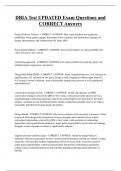DBIA Test UPDATED Exam Questions and
CORRECT Answers
Project Delivery System - CORRECT ANSWER- How team members are organized,
establishes when parties engage, determines roles of parties, and determines sequence of
design, procurement, and construction (db, cmar, dbb)
Procurement Method - CORRECT ANSWER- how team members are selected (QBS, best
value, low price, sole source)
contracting approach - CORRECT ANSWER- how team members are paid (fp, gmp, cost
reimbursement, target price, unit price)
Design-Bid-Build (DBB) - CORRECT ANSWER- linear, sequential process, A/E selected on
qualifications, GC selected on low price, design is fully completed without input from GC,
A/E acting in owner's interests, with a historically strong bond, process is well-established
and understood
construction manager at risk - CORRECT ANSWER- similar org structure to DBB,
construction manager selected by QBS or best value, contractor provides precon services,
negotiated gmp contracting approach, open book estimating process, potential to fast track
project, construction cost determined before design completed, potential issues over what is
reasonably inferable from gmp design documents
Design-Build - CORRECT ANSWER- The owner contracts with one entity (a person or firm)
to provide both design and construction services, designer and contractor have a direct
contractual relationship, selected by QBS or best value, wide spectrum of contracting
approaches and organizational structures, single point responsibility, owner does not manage
designer, owner exposure to claims is significantly reduced
engineer procure construct (epc) - CORRECT ANSWER- similar to design build, in
industrial and power generation sectors, systems and performance testing are central to scope,
contractor will typically perform engineering with its in-house staff, owner has need for
single point responsibility, contracts include plant and process performance guarantees,
contract items include performance and schedule liquidated damages and limitations of
liability
, Multiple Prime Contracting - CORRECT ANSWER- owner contracts with multiple trade
contractors, attributes are typically similar to dbb, owner's ability to schedule and coordinate
the work
Integrated Project Delivery (IPD) - CORRECT ANSWER- multi-party agreement - all parties
equal, QBS procurement and target pricing contract approach, private sector use (limited at
this time), key: owner's ability to accept risk
public-private partnership (p3) - CORRECT ANSWER- Instead of government building and
maintaining major infrastructure (such as highway, water treatment plant), build and
maintenance is outsourced to a private company. Opposed by public sector unions. this is not
considered a delivery system but its underlying approaches are delivery systems and typically
use DB. multiple procurement and contracting approaches
shift left - CORRECT ANSWER- intense efforts to establish scope early in the process;
drives early team formation to include key trade subcontractors; can enable big decisions to
be made early, affect project outcomes at lowest cost, establish a need for co-location and
collaboration, and compress time during concurrent design and construction
traditional design build - CORRECT ANSWER- typically two-phase best value procurement
with lump sum contract; owner defines project requirements and scope of prescriptive work;
use of performance-based technical requirements with limited prescriptive specifications
progressive design build - CORRECT ANSWER- design and price are progressively
developed after the design-builder is under contract; final project cost and schedule
commitment is not established as part of the selection process; two phases: preliminary
services and final design and construction services
criteria documents - CORRECT ANSWER- describe the end result
bridging documents - CORRECT ANSWER- prescribes how to achieve the end result
design bid build paradigm - CORRECT ANSWER- prior to bidding, owner undertakes a
process to design the project and all of its details to 100% complete plans and specs. the
owner is therefore responsible for success or failure of details of the design, and warrants the




